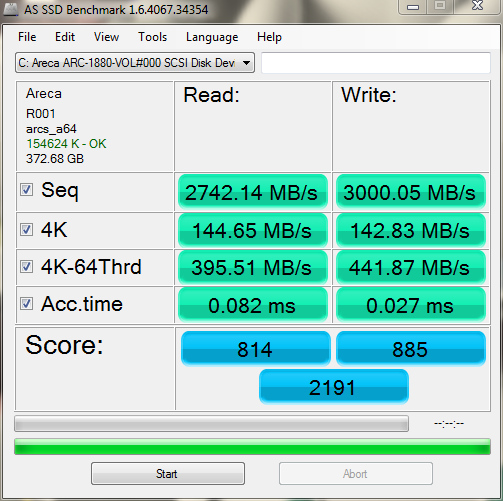AS SSD BENCHMARK V.1.6
As much as AS SSD will show you the amazing numbers, alot has to be said of the PCIe interface which eliminates any bottlenecks of SATA 2 and even SATA 3. Without this, we simply couldn’t pull up numbers any where near 3GB/s write as seen here.
AS SSD is run in cache and there is no way to adjust accordingly in order to eliminate the cards cache.Quite frankly though, the sole purpose of this cache is to allow us to stretch our results that much further.
2.7GB/s Read – 3GB/s Write
I am proud to say that these are the highest benchmarks I have ever reached with this software program. The AS SSD .ISO Test measures transfer/file copying speeds. Can you imagine copying an iso file in less than a second?
And finally, we will show the speed with compressible data, a new test for AS SSD.
HD TACH V. 3.4
HDTach tests void of the cards cache and the red ‘burst’ bar sits just shy of of 2GB/s while the graph is indicating 1500mb/s average.
Pg 1 – Introduction
Pg2 – Test Bench & Protocol
Pg3 – Preliminaries, ATTO & Crystal DiskMark
Pg4 – AS SSD & HD Tach
Pg5 – Windows Index & HDTune Pro
Pg6 – IOMeter & Everest
Pg7 – PCMark Vantage and Conclusions
Would you like to discuss testing or see further tests conducted?
 The SSD Review The Worlds Dedicated SSD Education and Review Resource |
The SSD Review The Worlds Dedicated SSD Education and Review Resource | 


Mr. Alcorn, Much thanks for a very well done and insightful review.
I ran AS SSD and HDTune Pro using Areca 1880ix-24 and 6 Vertex 3 MAX IOPS in RAID 0 and got similar results except for acc.time (AS SSD and HDTune Pro) .244ms. What would cause such a difference in access timings (.244ms vs. .082ms)? Thanks.
Gil-
There could be a number of reasons why this hold true. First, latency is not as low with the SF SSDs. However, depending upon your cache capacity the latency of the SF drives could be irrelevant. So lets start with how much cache (4 GB?) and also, more importantly, which motherboard?
If your motherboard has the NF200 that is going to probably be the culprit. I had to switch from the E759 to the E760 specifically because of the NF200. While it multiplies the bandwidth, it adds serious latency concerns. To test easily, place your raid card in PCIe Slot #1, your board will boot with the GPU in other slots. I know this can be a pain with Dual and TRI-SLI. However, if you have the NF200 you should see a tremendous drop in latency.
Remember, a slot with x8 without the NF200 is faster that a x16 with the NF200 when it comes to raid cards!
Please reply back and let us know how your results turn out! Very interesting!
Thanks for reading,
Paul Alcorn